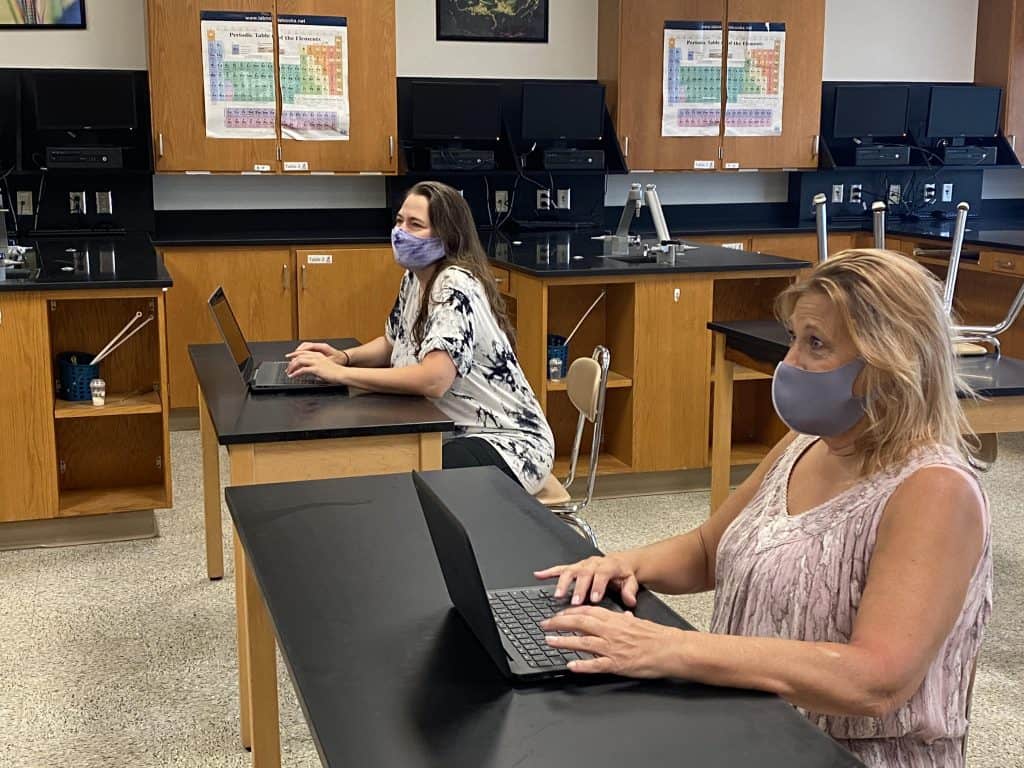

Educators in the Lenape Regional High School District met new and familiar colleagues over four days of professional development earlier this month at their respective schools.
Five instructors from Seneca High School were among those who learned the tools for a school year unlike any other that was to begin Sept. 10: lessons on accessing technology within the four schools (Seneca, Shawnee, Cherokee and Lenape) and at home; learning new software and websites; amending plans to fit virtual and in-person instruction; and following state Department of Education mandates.
The lessons inspired confidence.
“My only nerves come in with the fact that we are working with teenagers, who by nature tend to challenge procedures and mandates,” said Amy Mosser, who teaches Algebra II.
“At Seneca, we have a great faculty-student relationship though, and I hope we can use those relationships to help our students realize that the rules are there for their safety.”
Spanish teacher Mariem Silva learned about educational websites. Chemistry teacher Dusty Carroll taught a college summer program and acquired new knowledge on websites that aid in collaboration and completion of courses.
The second day of professional development on Sept. 2 allowed for staffers to have sessions in their subject areas and learn what will be vital to the new hybrid model of education. But some unique challenges remained for the five Seneca teachers.
Thomas Xenakis, who teaches physics and engineering, knew laboratory activities would be a task to resolve with some students in the 100-percent remote learning group. A proposed solution was to have the students at home collect and analyze data while the others complete experiments and test theories.
Other teachers were concerned with building connections between students with limited to no in-person interactions. Building administrators asked teachers during the training to explain why they wear face coverings, evoking personal responsibility and respect for others.
“It’s thinking about others. It would be selfish for me to not wear a mask,” noted Kathleen Witts, who teaches special education math at Seneca. “ … And then it’s like, ‘What else can we do for someone else?’ Wearing a mask is something really simple. It’s a good way to teach the kids it’s not about yourself, it’s about others.”
The five Seneca teachers shared their excitement about adding prerecorded lessons and collaborative exercises into curriculums so students can learn at a comfortable pace and better absorb information. Silva used Pear Deck’s Google Chrome extension to make her PowerPoints interactive so her class can easily stop, start and resume. Xenakis has studied software to refine his lesson plans.
The instructors admitted that flexibility and enhanced communication with parents outweigh inevitable remote issues that will arise during classes, such as WiFi weakening; video signals lapsing; or uncontrollable environments, like motion-activated lights turning off.
“We as teachers, and if you ask anyone else, are all getting better at this,” Xenakis opined. “We’re finding more ways to enhance and do the things we do and finding new ways to help boost learning and engagement.”
Witts and Carroll admitted learning more about student learning styles, such as who does best with independent work and who needs face-to-face interaction. The colleagues agreed they gathered more knowledge about parents and why some students have greater issues completing coursework.
“When you’re in school, you don’t see that,” Witts explained. “It shows us more of the different types of kids and families that we have and the different situations where we could help and give some kids more independence for that.”
The teachers agreed teens will make the most of a situation and “roll with” mistakes or hiccups in class.
Mosser compared returning to school with childbirth: extremely difficult, painful and scary at first.
“We stretched outside of our comfort zone and became better teachers for it,” she continued. “Like childbirth, we are willingly taking another shot at it — albeit a little bit nervously and cautiously — but now we know we can do it and it’ll all be okay in the end.”









